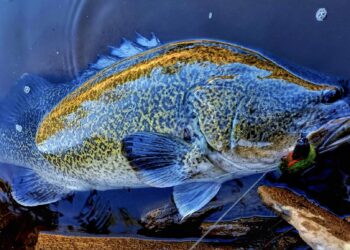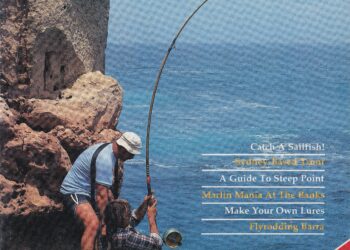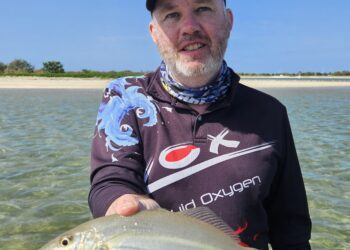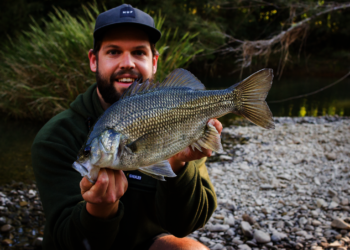How-to: Jig It
The new age of deep jigging offers keen fishos the choice of arm-burning heavy metal or the more subtle but equally productive “occy” lures. JAMIE CRAWFORD explores the merits of both jigging styles.
ALTHOUGH deep water jigging is far from being a new form of angling, to many of us younger fishos it’s definitely come into view that way. Jigging has had a rebirth over the past several years, with major advancements in tackle almost single-handedly revamping the popularity of this hard-core style of sportfishing.
The once-standard heavy monofilament, large overhead reels and stout ’glass rods have been replaced with next gen braided line, light carbon rods and high-end jigging reels, making the whole exercise a lot easier and more efficient. Don’t get me wrong, jigging is still a highly-energetic and physically demanding style of fishing, but with the lighter new age tackle, at least some of the aftermath arm-burning is reduced.
Heavy metal jigging has been the time-honoured method of jigging in the past, and involves repeatedly cranking a 200g – 400g slice of metal up from a deep reef – hence the sore arms. It was, and still is, a proven technique on many of our deep reefs, with the Seriola gang of species – kingfish, amberjack, samsons – the pinnacle for deep water jiggers.
And while heavy metal jigging is still a successful practice, we now have a selection of fantastic slow jigs on the market, bringing a fresh angle of jigging to the modern deep water fisho. Slow jigs, or occy jigs, are a type of metal jig but the retrieve and style of fishing is totally different and far less taxing on the body compared to conventional heavy metal jigging. Slow jigs are providing a welcome relief in between heavy metal jigging, and we are finding the different style of jigs and techniques are actually targeting different species of fish, even on the same reef.

Heavy Metal
We will use heavy metal jigs on reefs deeper that 40m down here in South Oz, with the majority of our jigging reefs in 60 to 80m. After locating our chosen reef, we try to determine our line and speed of drift and then position our boat accordingly. Ideally we will try to drift down the tapering edge of the mount, trying to avoid the shallowest peak of the reef. The summit of these reefs are covered in rubbish fish such as wrasse, sergeant baker and barber perch.
If the drift speed is too quick, whether because of current or wind, we will anchor over the reef – once again avoiding the shallowest tip. Using the sounder, we will try to position ourselves near a bait ball, or over a defined drop-off. If we are in 100m of water, and our reef rises to within 60m of the surface, then we will try to anchor in about 80m of water – mid-point of the mount.
Once in position, we vertically drop our metal jigs all the way to the bottom. The standard retrieve is a fast short-pump and wind. As the rod tip is dropped, one clean reel revolution gathers the loose line, and the rod is quickly lifted again. By standardising the reel movement as well as the rod lifts, it’s easier to slip into a rhythm.
I find that my whole upper-body slides into the routine, while other fishos use their hips in the jigging motion – whatever is comfortable and works for you. Fast jigging retrieves are more effective for our target species, too slow and we get inundated with smaller reef species such as swallowtail.
We work our jigs up to around 10 – 15m off the reef, then we free-spool the jig back to the bottom and start again. If we jig too high up in the column, we end up leaving our target species behind, and we start hooking barracouta, silver trevally, and even tuna in the mid to upper water layers.
These species can be great fun in their own right (bar the ’couta!), but when you’re geared up for tackle-smashing brutes of the deep, these other species can get in the road. On our deep reefs down south we target samson fish and yellowtail kings on the heavy metal, and in deep water these guys are tough customers.
The standard jigging outfit on the deep reefs is a 15 – 24kg fast taper jig stick. At around 1.6 to 1.7m, these powerful blanks are relatively short, compact rods capable of sticking it to big, powerful fish. The reels to match are also specifically designed for the job. The choice between overhead or threadline boils down to personal preference, with high retrieves above 6:1 favoured.
The new age jig reels are capable of some serious drag pressure – pressures almost too heavy for the average fisho to handle (myself included!). Coupled with 50 or 80lb braid and you have a serious jigging weapon. We tie a 3m length of 80lb mono via an improved Albright to the braid double to act as a shock absorber; alternatively, a wind-on leader of similar weight can be used.
There is a good selection of heavy metal jigs on the market these days, but some proven performers for us have been Sea Rocks, Power Jigs, Turkey Sliders and Knife Jigs. Colour varies depending on species and location, but pinks and reds are a favourite down south. The weight of the jig will vary depending on water depth and drift or current speed, but a 300g jig is our standard item on our reefs.
Slow Jigs
Slow jigs are a relatively new item to sweep across Oz. While heavy metal jigs represent a fleeing baitfish, slow jigs mimic the appearance and sluggish rhythmic movement of small cephalopods such as octopus, squid and cuttlefish. As these food items are slow, that’s exactly how we want to fish these jigs – slowly.
We fish the same water as we do with heavy metal, but we can also fish shallower drops to around 20m. As with heavy jigs, if we can slowly drift the reef to cover ground then we will, otherwise we will have to fish the reef at anchor. Lately we have been mixing up our styles of deep water jigging, alternating between heavy metal and slow jigs in the same day; it’s more user-friendly on the body and we’re seeing a larger variety of fish hit the surface.
Where fast retrieved heavy metal is effective on kingfish, samson fish and bluefin tuna, the slower movement of occy jigs appeals to the reef species such as snapper, nannygai (red snapper), blue morwong, and even thumping KG whiting. In other parts of the country, pearl perch and WA dhufish are proving to be regulars on the slow jigs.
As you can see, the slow jigs are targeting the finer table fish, so with a change of jigging approach we are topping up the chilly-bin with some prime fillets. Small samson fish and rat kings also swipe the slow jigs, but not as frequently as they do heavy metal jigs.
The technique for working slow jigs is a lot easier and less energetic than using heavy metal. We cast away from the boat, allow the slow jig reach the bottom, and then begin a smooth, slow lift and wind. The retrieve speed is not dissimilar to that of a soft plastic, with the slower retrieve speeds better. Once underneath the boat, we continue the retrieve until about 10m up, then we wind in and repeat.
The bites on slow jigs are often quite delicate, and a lot of the time will require striking – similar to using bait. The hook-up on a heavy jig, however, is a lot more deliberate and aggressive, and is more of an all-in-one smash and run.
The tackle used for fishing with slow jigs is less specific than that used with heavy metal jigging. Lighter outfits in the 8 – 12kg bracket are used for slow jigging, with longer rods around 1.9 – 2.0m preferred. Having a fast action rod with a fair degree of sensitivity is important for slowly working the jig, and for detecting those subtle bites.
Once again the choice between threadline or overhead is purely personal, but seeing as fast retrieves aren’t necessary and the target species are less brutal, there are a lot of all-purpose reels on the market that will suffice. Spooling the outfit with 20 – 30lb braid will handle most situations with ease. We tie a 3m length of 40lb mono via an improved Albright to the braid double to act as a shock absorber.
Gillies Octa Lure, Shimano Lucanus, Duel Salty Rubber and Daiwa Bay Rubber are all varieties of slow jigs that are proving effective on our southern reef species, with the 80 – 200g models useful over our deeper reefs.
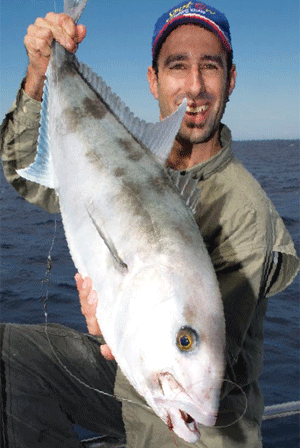
Pros and Cons
As mentioned previously, slow jigs are the gentleman’s form of jigging. They are easier and less taxing on the body to use, and provide a welcome break in between heavy metal jigging.
The outfit used for fishing slow jigs is less specific, with a general 8 – 12kg snapper outfit spooled with 20 – 30lb braid sufficing as a slow jig combo. Of course you can spend the extra dosh and invest in a specific slow jig outfit if you so desire, but it’s not necessary. Heavy metal jigging tackle, on the other hand, is more specific, and if you’re serious about this style of jigging then a dedicated jig stick is a must.
Slow jigs are intricate items of tackle, and they do come with a price tag. On average, they are double the price of a standard metal jig. At around $20 – $25 for a slow jig, they’re not a cheap item.
Slow jigs have proven to be effective on a host of reef species, but some have been less desirable. Toothy reef species such as leatherjackets have shown a liking towards the slow jigs, eating the rubber skirts from the jigs and rendering the item useless. Replacement skirts are available from a few of the tackle companies such as Shimano.
Although slow jigs are effective on our tough southern reef species, they weren’t designed with these fish in mind. The majority of jigs come standard with a pair of Dyneema-spliced assist hooks, and although the hooks are reputable brand they are too small and too fine gauge for our target species. We have had a few hooks fail under load, and these days we upgrade the terminals to be on the safe side.
Removing the fitted hooks from the stainless ring is relatively easy, and allows another set to be added. These days we attach a single 2/0 Dacron-spliced assist hook to the stainless ring, thus giving greater holding strength on the bigger reef-dwellers.
With these pros and cons aside, the real choice is deciding what species you would prefer to target from the reef. The bigger, tougher brawlers are a better chance on the heavy metal, while the smaller, tastier reef species are suckers for slow jigs … take your pick.













